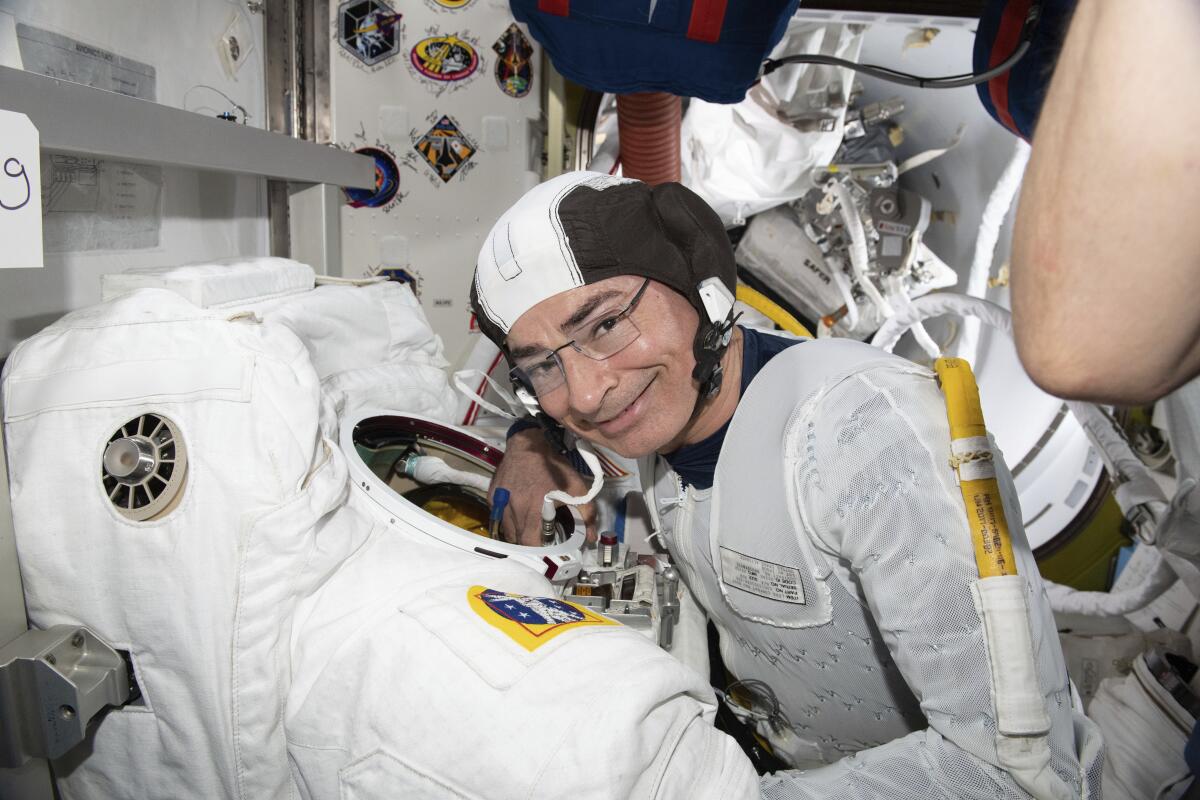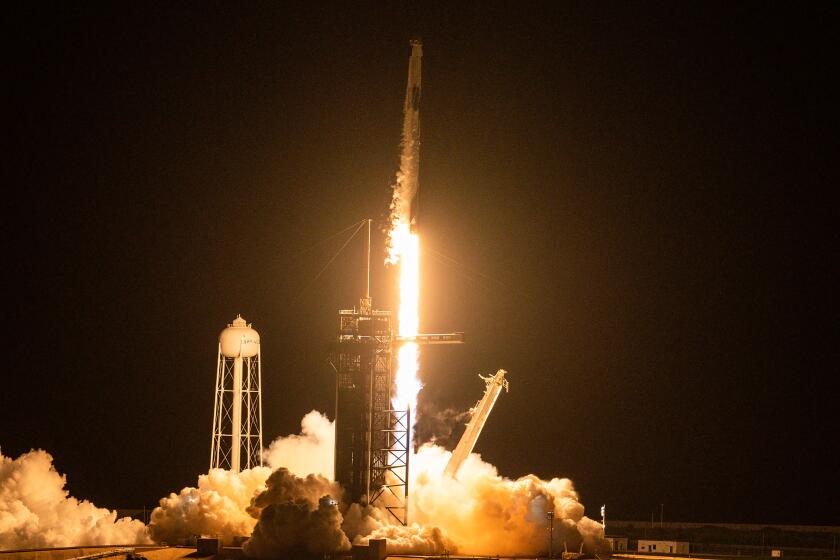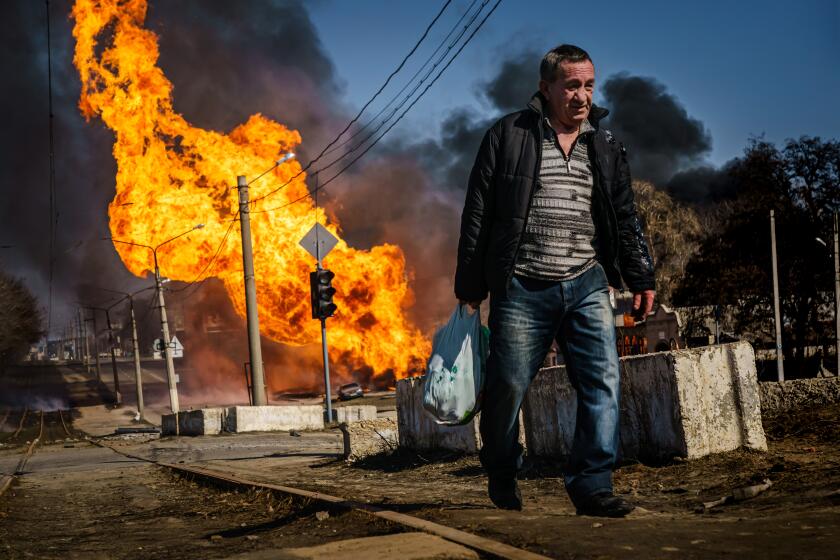NASA astronautâs ride home with Russians may be trickiest part of yearlong space mission

CAPE CANAVERAL, Fla. â U.S. astronaut Mark Vande Hei has made it through nearly a year in space, and now faces what could be his trickiest assignment yet: riding a Russian capsule back to Earth in the midst of deepening tensions between the countries.
NASA insists Vande Heiâs homecoming plans at the end of the month remain unchanged, even as Russiaâs invasion of Ukraine has resulted in canceled launches, broken contracts and an escalating war of words by the Russian Space Agencyâs hard-line leader. Many worry Dmitry Rogozin is putting decades of a peaceful off-the-planet partnership at risk, most notably at the International Space Station.
Vande Hei â who on Tuesday breaks the U.S. single spaceflight record of 340 days â is due to leave with two Russians aboard a Soyuz capsule for a touchdown in Kazakhstan on March 30. The astronaut and flight engineer will have logged 355 days in space by then, setting a U.S. record. The world record of 438 continuous days in space belongs to Russia.
Retired NASA astronaut Scott Kelly, Americaâs record-holder until Tuesday, is among those sparring with Rogozin, a longtime ally of Vladimir Putin. Enraged by whatâs going on in Ukraine, Kelly has returned his Russian medal for space exploration to the Russian Embassy in Washington.
Despite the deadly conflict down here, Kelly believes the two sides âcan hold it togetherâ up in space.
âWe need an example set that two countries that historically have not been on the most friendly of terms, can still work somewhere peacefully. And that somewhere is the International Space Station. Thatâs why we need to fight to keep it,â Kelly said.
NASA wants to keep the space station running until 2030, as do the European, Japanese and Canadian space agencies; the Russians have not committed beyond the original end date of 2024 or so.
The U.S. and Russia are the prime operators of the orbiting outpost, permanently occupied for 21 years. Until SpaceX started launching astronauts in 2020, Americans regularly hitched rides on Russian Soyuz capsules for tens of millions of dollars per seat. The U.S. and Russian space agencies are still working on a long-term barter system in which a Russian would launch on a SpaceX capsule beginning this fall and an American would fly up on the Soyuz. That would help ensure a U.S. and Russian station presence at all times.
For the first time ever, a crew made up entirely of non-professional astronauts launched to orbit, commanded by billionaire tech entrepreneur Jared Isaacman.
Vande Hei, 55, a retired Army colonel, moved into the space station last April, launching on a Soyuz from Kazakhstan with Pyotr Dubrov and another Russian. He and Dubrov stayed twice as long as usual to accommodate a Russian film crew that visited in October.
As the situation 260 miles below intensified last month, Vande Hei acknowledged he was avoiding conversations about Ukraine with Dubrov and Anton Shkaplerov, their Russian commander. Three more Russians will blast off from Kazakhstan on Friday to replace them.
âWe havenât talked about that too much. Iâm not sure we really want to go there,â Vande Hei told a TV interviewer in mid-February.
Space station operations continue as always â in orbit and on Earth, according to NASA.
âIt would be a sad day for international operations if we canât continue to peacefully operate in space,â said NASAâs human spaceflight chief Kathy Lueders, who noted it would be âvery difficultâ to go it alone.
The Timesâ Marcus Yam, no stranger to war photography, gives a first-person account from Ukraine.
To mark Tuesdayâs milestone, NASA turned to Twitter to gather questions for video-recorded responses, and some asked whether Vande Hei might switch to an American ride home. SpaceX is taking three wealthy businessmen and their ex-astronaut escort to the space station at the end of March for a brief visit. Then in mid-April, SpaceX will deliver four astronauts for NASA before bringing back four who have been on board since November.
NASA and SpaceX officials refuse to speculate on whether a seat could be made available. They say a NASA plane and small team will be on hand in Kazakhstan, as usual, to whisk Vande Hei back home to Houston.
Former NASA astronaut Heidemarie Stefanyshyn-Piper, whose father was born in Ukraine, concedes itâs a difficult situation.
âWeâre sanctioning Russia. Companies are pulling out of doing business in Russia. But then yet you still have the U.S. government â the space agency â doing business with the Russians,â she said. âYou canât push a button and separate the twoâ sides of the space station.
Besides threatening to pull out of the space station and drop it on the U.S., Europe or elsewhere, Rogozin had the flags of other countries covered on a Soyuz rocket awaiting liftoff with internet satellites earlier this month. The launch was called off, after the customer, London-based OneWeb, refused his demands that the satellites not be used for military purposes and the British government halt its financial backing.
The European Space Agency also is reeling. After missing a 2020 launch deadline for its Mars rover â a joint European-Russian effort â the project was on track for a September liftoff from Kazakhstan. Now itâs probably off until 2024, the next opportunity for Earth and Mars to be properly aligned. And Russia has pulled its staff out of the French-run launch site in South America, suspending Soyuz launches of European satellites.
All this comes on top of the Russian governmentâs anti-satellite missile test in November that added countless pieces of junk to the debris already encircling Earth and put the space stationâs four Americans, two Russians and one German on alert for days.
Ukrainian tennis player Yuliia Zhytelna has found support from Russian Cal State Northridge doubles partner Ekaterina Repina during a very stressful time.
Jeffrey Manber, now with the private Voyager Space company, helped forge U.S. and Russian ties back in the mid-1990s, with the first piece of the space station launching in 1998. He sees the outpost as âone of the final holdouts of collaborationâ between the two countries. But, he added, âthere is no going back if the partnership is ended and the result is a premature ending of the ISS program.â
Regardless of how things play out at the space station, John Logsdon, professor emeritus at George Washington University, expects it will mark the end of large-scale space cooperation between Russia and the West.
âRussia has been moving toward China already, and the current situation will probably accelerate that move,â he said.
Although Vande Hei has been silent on Twitter, Kelly and others have gone into overdrive, taking offense at Rogozinâs threats.
Elon Muskâs private SpaceX took a swipe at Rogozin after he said Russia would stop supplying rocket engines to U.S. companies â Northrop Grumman and United Launch Alliance â adding that they could use broomsticks to get to orbit.
At a launch last week, a SpaceX official responded: âTime to let the American broomstick fly and hear the sounds of freedom.â









